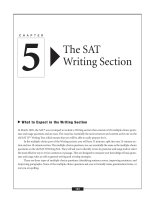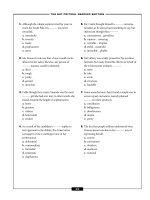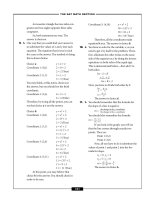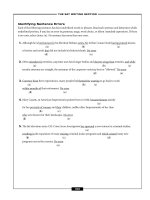The sat math section 1 potx
Bạn đang xem bản rút gọn của tài liệu. Xem và tải ngay bản đầy đủ của tài liệu tại đây (125.29 KB, 6 trang )
■
If given a percentage, write it in the numerator
position of the number column. If you are not
given a percentage, then the variable should be
placed there.
■
The denominator of the number column repre-
sents the number that is equal to the whole, or
100%. This number always follows the word “of”
in a word problem.
■
The numerator of the number column represents
the number that is the percent.
■
In the formula, the equal sign can be inter-
changed with the word “is.”
Examples:
Finding a percentage of a given number:
What number is equal to 40% of 50?
Solve by cross multiplying.
100(x) = (40)(50)
100x = 2,000
ᎏ
1
1
0
0
0
0
x
ᎏ
=
ᎏ
2
1
,0
0
0
0
0
ᎏ
x = 20 Therefore, 20 is 40% of 50.
Finding a number when a percentage is given:
40% of what number is 24?
Cross multiply:
(24)(100) = (40)(x)
2,400 = 40x
ᎏ
2,
4
4
0
00
ᎏ
=
ᎏ
4
4
0
0
x
ᎏ
60 = x Therefore, 40% of 60 is 24.
Finding what percentage one number is of
another:
What percentage of 75 is 15?
Cross multiply:
15(100) = (75)(x)
1,500 = 75x
ᎏ
1,
7
5
5
00
ᎏ
=
ᎏ
7
7
5
5
x
ᎏ
20 = x Therefore, 20% of 75 is 15.
Ratio and Variation
A ratio is a comparison of two quantities measured in
the same units. It is symbolized by the use of a colon—x:y.
Ratio problems are solved using the concept of
multiples.
Example:
A bag contains 60 red and green candies. The
ratio of the number of green to red candies is 7:8.
How many of each color are there in the bag?
From the problem, it is known that 7 and 8
share a multiple and that the sum of their prod-
uct is 60. Therefore, you can write and solve the
following equation:
7x + 8x = 60
15x = 60
ᎏ
1
1
5
5
x
ᎏ
=
ᎏ
6
1
0
5
ᎏ
x = 4
Therefore, there are (7)(4) = 28 green candies
and (8)(4) = 32 red candies.
Variation
Variation is a term referring to a constant ratio in the
change of a quantity.
■
A quantity is said to vary directly with another if
they both change in an equal direction. In other
words, two quantities vary directly if an increase
# %
__ = ___
75 100
x15
# %
__ = ___
x 100
40
24
# %
__ = ___
50 100
40
x
–THE SAT MATH SECTION–
142
5658 SAT2006[04](fin).qx 11/21/05 6:44 PM Page 142
in one causes an increase in the other. This is also
true if a decrease in one causes a decrease in the
other. The ratio, however, must be the same.
Example:
Assuming each child eats the same amount, if
300 children eat a total of 58.5 pizzas, how
many pizzas will it take to feed 800 children?
Since each child eats the same amount of pizza,
you know that they vary directly. Therefore, you
can set the problem up the following way:
ᎏ
Ch
P
i
i
l
z
d
z
r
a
en
ᎏ
=
ᎏ
5
3
8
0
.
0
5
ᎏ
=
ᎏ
80
x
0
ᎏ
Cross multiply to solve:
(800)(58.5) = 300x
46,800 = 300x
ᎏ
46
3
,
0
8
0
00
ᎏ
=
ᎏ
3
3
0
0
0
0
x
ᎏ
156 = x
Therefore, it would take 156 pizzas to feed 800
children.
■
If two quantities change in opposite directions,
they are said to vary inversely. This means that as
one quantity increases, the other decreases, or as
one decreases, the other increases.
Example:
If two people plant a field in six days, how may
days will it take six people to plant the same field?
(Assume each person is working at the same rate.)
As the number of people planting increases, the
days needed to plant decreases. Therefore, the
relationship between the number of people and
days varies inversely. Because the field remains
constant, the two expressions can be set equal
to each other.
2 people × 6 days = 6 people × x days
2 × 6= 6x
ᎏ
1
6
2
ᎏ
=
ᎏ
6
6
x
ᎏ
2= x
Thus, it would take six people two days to plant
the same field.
Rate Problems
You will encounter three different types of rate prob-
lems on the SAT: cost, movement, and work-output.
Rate is defined as a comparison of two quantities with
different unites of measure.
Rate =
Examples:
ᎏ
m
ho
il
u
e
r
s
ᎏ
,
ᎏ
d
h
o
o
ll
u
a
r
rs
ᎏ
,
ᎏ
po
co
u
s
n
t
d
ᎏ
Cost Per Unit
Some problems on the SAT will require you to calcu-
late the cost of a quantity of items.
Example:
If 60 pens cost $117.00, what will the cost of
four pens be?
ᎏ
t
#
o
o
ta
f
l
p
c
e
o
n
s
s
t
ᎏ
=
ᎏ
1
6
1
0
7
ᎏ
=
To find the cost of 4 pens, simply multiply
$1.95 × 4 = $7.80.
Movement
When working with movement problems, it is impor-
tant to use the following formula:
(Rate)(Time) = Distance
Example:
A scooter traveling at 15 mph traveled the
length of a road in
ᎏ
1
4
ᎏ
of an hour less than it took
when the scooter traveled 12 mph. What was
the length of the road?
First, write what is known and unknown.
Unknown = time for scooter traveling
12 mph = x
Known = time for scooter traveling 15 mph =
x –
ᎏ
1
4
ᎏ
Then, use the formula, (Rate)(Time) =
Distance to make an equation. The distance of
$1.95
ᎏ
pen
x units
ᎏ
y units
–THE SAT MATH SECTION–
143
5658 SAT2006[04](fin).qx 11/21/05 6:44 PM Page 143
the road does not change; therefore, you know
to make the two expressions equal to each other:
12x = 15(x –
ᎏ
1
4
ᎏ
)
12x =15x –
ᎏ
1
4
5
ᎏ
–15x –15x
ᎏ
–
–
3
3
x
ᎏ
=
x =
ᎏ
5
4
ᎏ
, or 1
ᎏ
1
4
ᎏ
hours
Be careful, 1
ᎏ
1
4
ᎏ
is not the distance; it is the time.
Now you must plug the time into the formula:
(Rate)(Time) = Distance. Either rate can be used.
12x = distance
12(
ᎏ
5
4
ᎏ
) = distance
15 miles = distance
Work-Output Problems
Work-output problems are word problems that deal
with the rate of work. The following formula can be
used of these problems:
(rate of work)(time worked) = job or part of job
completed
Example:
Danette can wash and wax two cars in six
hours, and Judy can wash and wax the same
two cars in four hours. If Danette and Judy
work together, how long will it take to wash and
wax one car?
Since Danette can wash and wax two cars in six
hours, her rate of work is , or one car
every three hours. Judy’s rate of work is there-
fore , or one car every two hours. In this
problem, making a chart will help:
Rate Time = Part of Job Completed
Danette
ᎏ
1
3
ᎏ
x = 1 car
Judy
ᎏ
1
2
ᎏ
x = 1 car
Since they are both working on only one car,
you can set the equation equal to one:
ᎏ
1
3
ᎏ
x +
ᎏ
1
2
ᎏ
x = 1
Solve by using 6 as the LCD for 3 and 2:
6(
ᎏ
1
3
ᎏ
x) + 6(
ᎏ
1
2
ᎏ
x) = 6(1)
2x + 3x = 6
ᎏ
5
5
x
ᎏ
=
ᎏ
6
5
ᎏ
x = 1
ᎏ
1
5
ᎏ
Thus, it will take Judy and Danette 1
ᎏ
1
5
ᎏ
hours to
wash and wax one car.
Special Symbols Problems
The SAT will sometimes invent a new arithmetic oper-
ation symbol. Don’t let this confuse you. These prob-
lems are generally very easy. Just pay attention to the
placement of the variables and operations being
performed.
Example:
Given a ∇ b = (a × b + 3)
2
, find the value of 1 ∇ 2.
Fill in the formula with 1 being equal to a and 2
being equal to b.
(1 × 2 + 3)
2
= (2 + 3)
2
= (5)
2
= 25
So, 1 ∇ 2 = 25.
Example:
b
ca
2
31
If =
_____
+
_____
+
_____
a − b a − c b − c
c b a
Then what is the value of . . .
2 cars
ᎏ
4 hours
2 cars
ᎏ
6 hours
ᎏ
–
4
15
ᎏ
ᎏ
–3
–THE SAT MATH SECTION–
144
5658 SAT2006[04](fin).qx 11/21/05 6:44 PM Page 144
Fill in variables according to the placement of
number in the triangular figure; a = 1, b = 2,
and c = 3.
ᎏ
1–
3
2
ᎏ
+
ᎏ
1–
2
3
ᎏ
+
ᎏ
2–
1
3
ᎏ
= –
ᎏ
1
3
ᎏ
+ –1 + –1 = –2
ᎏ
1
3
ᎏ
Counting Principle
Some word problems may describe a possibilities for
one thing and b possibilities for another. To quickly
solve, simply multiply a × b.
For example, if a student has to choose one of 8
different sports to join and one of five different com-
munity service groups to join, we would find the total
number of possibilities by multiplying 8 × 5, which
gives us the answer: 40 possibilities.
Permutations
Some word problems may describe n objects taken r at
a time. In these questions, the order of the objects matters.
To solve, you will perform a special type of calcu-
lation known as a permutation. The formula to use is:
n
P
r
=
For example, if there are six students (A, B, C, D, E,
and F), and three will be receiving a ribbon (First
Place, Second Place, and Third Place), we can calcu-
late the number of possible ribbon winners with:
n
P
r
=
Here, n = 6, and r = 3.
n
P
r
= =
6
P
3
= = =
= 6 × 5 × 4 = 120
Combinations
Some word problems may describe the selection of r
objects from a group of n. In these questions, the order
of the objects does NOT matter.
To solve, you will perform a special type of calcu-
lation known as a combination. The formula to use is:
n
C
r
=
ᎏ
n
r
P
!
r
ᎏ
For example, if there are six students (A, B, C, D,
E, and F), and three will be chosen to represent the
school in a nationwide competition, we calculate the
number of possible combinations with:
n
C
r
=
ᎏ
n
r
P
!
r
ᎏ
Note that here order does NOT matter.
Here, n = 6 and r = 3.
n
C
r
=
ᎏ
n
r
P
!
r
ᎏ
=
6
C
3
=
ᎏ
6
3
P
!
3
ᎏ
=
ᎏ
3 ×
12
2
0
× 1
ᎏ
=
ᎏ
12
6
0
ᎏ
= 20
Probability
Probability is expressed as a fraction and measures the
likelihood that a specific event will occur. To find the
probability of a specific outcome, use this formula:
Probability of an event =
Example:
If a bag contains 5 blue marbles, 3 red marbles,
and 6 green marbles, find the probability of
selecting a red marble.
Probability of an event =
=
ᎏ
5+
3
3+6
ᎏ
Therefore, the probability of selecting a red
marble is
ᎏ
1
3
4
ᎏ
.
Multiple Probabilities
To find the probability that two or more events will
occur, add the probabilities of each. For example, in the
problem above, if we wanted to find the probability of
drawing either a red or blue marble, we would add the
probabilities together.
Number of specific outcomes
ᎏᎏᎏᎏ
Total number of possible outcomes
Number of specific outcomes
ᎏᎏᎏᎏ
Total number of possible outcomes
6 × 5 × 4 × 3 × 2 × 1
ᎏᎏᎏ
3 × 2 × 1
6!
ᎏ
(3)!
6!
ᎏ
(6 – 3)!
n!
ᎏ
(n – r)!
n!
ᎏ
(n – r)!
n!
ᎏ
(n – r)!
–THE SAT MATH SECTION–
145
5658 SAT2006[04](fin).qx 11/21/05 6:44 PM Page 145
The probability of drawing a red marble =
ᎏ
1
3
4
ᎏ
and the probability of drawing a blue marble =
ᎏ
1
5
4
ᎏ
.So,
the probability for selecting either a blue or a red =
ᎏ
1
3
4
ᎏ
+
ᎏ
1
5
4
ᎏ
=
ᎏ
1
8
4
ᎏ
.
Helpful Hints about Probability
■
If an event is certain to occur, the probability is 1.
■
If an event is certain not to occur, the probability
is 0.
■
If you know the probability of all other events
occurring, you can find the probability of the
remaining event by adding the known probabili-
ties together and subtracting from 1.
–THE SAT MATH SECTION–
146
5658 SAT2006[04](fin).qx 11/21/05 6:44 PM Page 146
Part 1: Five-Choice Questions
The five-choice questions in the Math section of the
SAT will comprise about 80% of your total math score.
Five-choice questions test your mathematical reason-
ing skills. This means that you will be required to apply
several basic math techniques for each problem. In the
math sections, the problems will be easy at the begin-
ning and will become increasingly difficult as you
progress. Here are some helpful strategies to help you
improve your math score on the five-choice questions:
■
Read the questions carefully and know the
answer being sought. In many problems, you will
be asked to solve an equation and then perform
an operation with that variable to get an answer.
In this situation, it is easy to solve the equation
and feel like you have the answer. Paying special
attention to what each question is asking, and
then double-checking that your solution answers
the question, is an important technique for per-
forming well on the SAT.
■
If you do not find a solution after 30 seconds,
move on. You will be given 25 minutes to answer
questions for two of the Math sections, and 20
minutes to answer questions in the other section.
In all, you will be answering 54 questions in 70
minutes! That means you have slightly more than
one minute per problem. Your time allotted per
question decreases once you realize that you will
want some time for checking your answers and
extra time for working on the more difficult prob-
lems. The SAT is designed to be too complex to fin-
ish. Therefore, do not waste time on a difficult
problem until you have completed the problems
you know how to do. The SAT Math problems can
be rated from 1–5 in levels of difficulty, with 1
being the easiest and 5 being the most difficult. The
following is an example of how questions of vary-
ing difficulty have been distributed throughout a
math section on a past SAT. The distribution of
questions on your test will vary.
1. 1 8. 2 15. 3 22. 3
2. 1 9. 3 16. 5 23. 5
3. 1 10. 2 17. 4 24. 5
4. 1 11. 3 18. 4 25. 5
5. 2 12. 3 19. 4
6. 2 13. 3 20. 4
7. 1 14. 3 21. 4
From this list, you can see how important it is
to complete the first fifteen questions before get-
ting bogged down in the complex problems that
follow. After you are satisfied with the first fifteen
questions, skip around the last ten, spending the
most time on the problems you find to be easier.
■
Don’t be afraid to write in your test booklet.
That is what it is for. Mark each question that
you don’t answer so that you can easily go back to
it later. This is a simple strategy that can make a
lot of difference. It is also helpful to cross out the
answer choices that you have eliminated.
■
Sometimes, it may be best to substitute in an
answer. Many times it is quicker to pick an
answer and check to see if it is a solution. When
you do this, use the c response. It will be the mid-
dle number and you can adjust the outcome to
the problem as needed by choosing b or d next,
depending on whether you need a larger or
smaller answer. This is also a good strategy when
you are unfamiliar with the information the
problem is asking.
■
When solving word problems, look at each
phrase individually and write it in math lan-
guage. This is very similar to creating and assign-
ing variables, as addressed earlier in the word
problem section. In addition to identifying what
is known and unknown, also take time to trans-
late operation words into the actual symbols. It is
best when working with a word problem to repre-
sent every part of it, phrase by phrase, in mathe-
matical language.
–THE SAT MATH SECTION–
147
5658 SAT2006[04](fin).qx 11/21/05 6:44 PM Page 147









